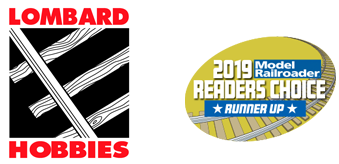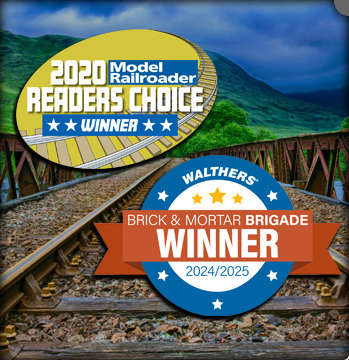ScaleTrains N
ScaleTrains Rivet Counter N SXT39623 DCC/ESU LokSound Equipped EMD SD40T-2 Union Pacific w/123" Snoot Nose UP #4429
- In Stock:
- 2
- Scale:
- N
- SKU:
- SXT39623
Description
Please note picture is representative of the item but may not be same road number. Always refer to product description for actual product details.
ScaleTrains Rivet Counter N SXT39623 DCC/ESU LokSound Equipped EMD SD40T-2
Union Pacific w/123" Snoot Nose UP #4429

Road Number Specific ScaleTrains
- All-new model
- Era: Mid 1990s – Early 2000s
- UP Series mixed, built 2-3/78 (ex-SP Series 8357 - 837)
-
Road numbers 4425 (ex-SP 8361) and 4429 (ex-SP 8371)
- Data label and lettering placement variations
- Plated over front and blanked rear red LED Pyle-National 17540 “UDE” Gyralites
- Blanked class lights with bolted plates front and rear
- Round walkway lights (non-operating)
- 123” “snoot” low short hood with wheel handbrake and round vent on top
- SP “split” cab sub-base doors with lift-off hinges
- Dash-2 cab with bolted side window panels, SP/SSW blue flag bracket, and modified “L” front window
- “Whip” radio antenna mounted on ground plane over dust bin and dual
- Locotrol antenna ground planes on cab roof with conduits
- Early electrical cabinet “zig-zag” seam, further from rear of cab
- Intermediate inertial air intake grills with top drip rail
- Extended-range dynamic brakes
- Front straight uncoupling levers with loop handles and two inner and two outer mounting brackets; angled rear uncoupling lever with four mounting brackets
- Fully-assembled
- Multiple road numbers
- Operating LED-illuminated front deck-mounted ditch lights*
- Printed and LED-illuminated number boards*
- Vapor Corp. cab roof HVAC
- Front late SP/UP-style pilot plow with MU hose doors and grab irons
- Front and rear 3-hose MU hose clusters with silver gladhands
- Body mounted knuckle couplers; Micro-Trains compatible
- Coupler box accepts Micro-Trains 1015/1016 couplers without modification
- Front pilot anticlimber
- Scale sectioned treadplate detail on the walkways
- Front "tall" stepwells and rear “ladder” steps
- SP nose headlight package
- Cab front door with additional door lock at top of door
- Tall clear wind wings with angled top corners mounted fore and aft of cab side window on both sides of cab
- Rear cab side vent on left side
- Standard EMD sunshades and long sunshade tracks
- Lost-wax brass Leslie RS-3L-R three-chime horn on clearance bracket, relocated to long hood roof
- Welded ECAFB (late)
- Handrail set with anticlimber front and rear end railing with outward facing mounting brackets, “breakaway” inner stanchions and chain
- Notched pilot faces with high mounted angled lifting slots
- Pilot-face mounted MU receptacle
- Detailed cab interior with separate floor, rear wall, seats, and standard AAR control stand
- Accurate hood door and long hood detail
- See-through standard 48” dynamic brake fan housings with fan blades visible inside
- See-through radiator intake compartment
- Etched-metal radiator exhaust grills with radiator shutters visible underneath
- Underbody frame rail with separate plumbing and traction motor cables
- Detailed HT-C trucks with Hyatt bearing caps, early center axle snubbers, sanding lines and brackets (outboard only
- Speed recorder first axle, left side
- Four-hole SP jacking pads
- Spare knuckle holders on fuel tank near fuel filler
- Sill-mounted EFCO
- Standard air tanks
- 4,400 gallon fuel tank with reinforced tank edges where sides meet the tank ends, dual fuel fillers, dual vertical gauges, round gauge on stand and vertical breather pipe
- Factory-applied wire grab irons, windshield wipers, trainline hoses with silver gladhands, and more
- Motor with 5-pole skew wound armature
- Dual flywheels
- All-wheel drive
- All-wheel electrical pick-up
- Directional LED headlights
- Printing and lettering legible even under magnification
- Operates on Code 55 and 80 rail
- Packaging safely stores model
- Minimum radius: 9 3/4”
- Recommended radius: 11”
DCC & sound equipped locomotives also feature
- ESU LokSound 5 DCC & Sound decoder with “Full Throttle”
- One (1) cube-type speaker
- EMD 16 Cylinder 645E3 prime mover
- Operates on both DC and DCC layouts**
DC/DCC & sound ready locomotives also feature
- Operates on DC layouts**
- DCC ready with E24 connector
* Lighting features operate when using an ESU decoder with appropriate programming while operating using DCC
**Lombard Hobbies Recommendation - As modelers ourselves we highly recommend ONLY running DCC on DCC systems and DC on DC systems, regardless of 'Dual-Mode' capability. This gives optimum performance and safeguards the unit from possible damage from running on a different system than originally intended and from any inexperienced operator errors.
Prototype History
Cataloged by EMD as an extra-cost option of their basic SD45-2 … “SD45-2 with cooling system modifications”, as described in EMD product manuals from the early 1970s … the SD45T-2 built upon the basic principle of the elephant ears, but in a permanent package. The modified radiator system, with large intakes mounted near walkway level, were designed with more efficient cooling in mind; in particular, faster recovery between tunnels and snowsheds. A success, SP would order a “T-2” variant of the SD45T-2s cousin, the SD40-2.
For the SD40T-2, the basic SD40-2/45-2 frame was stretched several feet to allow for an enlarged radiator compartment at the rear of the long hood, similar to what was done for the SD45T-2. Instead of the traditional placement of the radiator fans on the long hood roof, above the radiator cores and intake grills, the T-2 design placed the radiator fans and a diffuser assembly inside of the hood, below the radiator cores, and above a large, open radiator intake area placed at walkway level, resulting in faster, more efficient cooling. SP 8300, built in 1974, would be the first SD40T-2, whose fuel-efficient sixteen-cylinder 16-645E3 prime mover would prove to be more popular than the thirsty twenty-cylinder 20-645E3 used in the SD45T-2.
The SD40T-2 quickly became a fixture on the Southern Pacific, with a total of 240 units built for SP (and its Cotton Belt subsidiary) between 1974 and 1980. Built in multiple groups over that time period, they would exhibit various customer option changes, as well as EMD production differences. The first SD40T-2s, SP 8300-8306, and 8350-8356, were equipped with 116” long extended low short hoods to house Locotrol electronic equipment for remote control helper operations. Subsequent deliveries of units equipped with extended “snoot” low short hoods would measure 123” in length, reflecting EMD design changes across the product line. All SP/SSW units featured a large air conditioner housing on the cab roof (a welcome relief in the arid southwest), a 3-chime Nathan P3 airhorn offset to one side of the number board housing, and in the case of the Locotrol-equipped snoots, additional antenna ground planes and related cable conduits on the cab roof.
And of course, the units would be equipped with SP’s traditional Pyle-National “Gyralite” signal light package; while the SP 8300-8306, 8350-8356 only had signal lights on the front, changes to signal light policy saw all subsequent orders equipped with these safety appliances front and rear. The dual clear Gyralite assembly was intended to supplement the standard dual sealed-beam headlights as an attention-getter for motorists and pedestrians, while the single red-lensed Gyralite was meant as a safety feature for other trains. Tied into the brake system, when brake pressure dropped, as might happen when brake lines parted in a derailment or other mishap, the red Gyralite would automatically illuminate, extinguishing other headlights in the process, as a warning to trains on adjacent tracks that the train was in emergency, and to be wary of derailed equipment possibly fouling the tracks. The red light could also be activated manually, to act as a marker light.
In the Rockies, coal hauler Rio Grande faced similar operating challenges as SP in regards to long tunnels and heavy grades, such as the massive Moffat Tunnel, stretching over 6 miles long. Liking what it saw in the SD40T-2, Rio Grande would order them as well, taking delivery of its first units in 1974. Painted black with Aspen gold striping on the ends, sidesill, and number board box, a total of 73 units would be delivered to the Grande. Eschewing cab air conditioning, Rio Grande optioned a dual Gyralite assembly mounted in the low short hood (initial deliveries featured Mars brand signal lights, with their slightly different housing and light beam pattern), and most distinctively, requested a 4,000-gallon fuel tank, in contrast to the longer 4,400-gallon tank specified on all SP/SSW SD40T-2s.
Popular with engine crews and maintenance forces alike, the SD40T-2 would form the backbone of the SP and Rio Grande locomotive fleets well into the 1990s. Physical changes would appear to their fleets over the years; as a cost-cutting measure during the mid 1980s, as SP was struggling during an economic downturn, as well as the failed SPSF merger, the distinctive Gyralite signal lights, with their electric motors and moving parts, started to be removed, replaced by Prime Stratolite “digital” rotary beacons on the cab roof, which featured no moving parts to maintain. Also deleted were the expensive engineer’s side “L” front cab windows, replaced by cheaper, more standardized pieces of impact-resistant glazing.
On Rio Grande’s fleet, changes were subtle; following the success of their SD50s, in 1985 Rio Grande began to retrofit their SD40T-2s with Positive Traction Control, or PTC (different from the definition of PTC in the 2000s), which promised increased tractive effort on par with the newer SD50s. The retrofit consisted of wheelslip sensors added to all axles, as well as an electronic control cabinet added to the walkway behind the cab, on the conductor’s side. By 1989, the SP/SSW and Rio Grande SD40T-2 fleets would become one, with the purchase of Southern Pacific by Rio Grande Industries, with the better-known Southern Pacific name being used as the corporate image for the combined companies.
Into the 1990s, the SD40T-2s soldiered on. In 1991, the SP “Speed Lettering” paint scheme was introduced, with elements taken from both SP and Rio Grande. With a backlog of tired units needing overhauls and fresh paint, only a relatively small number of SP and Rio Grande SD40T-2s would be repainted into the striking new livery, but they looked sharp amongst a sea of grungy locomotives. While the new livery showed promise for a railroad that had struggled throughout the 1980s and was seemingly getting back on its feet in the 1990s, it was to be short lived, as Union Pacific would acquire Southern Pacific in 1996, with the merger taking effect on 9-11-96. As with past merger acquisitions, UP quickly absorbed the combined SP/SSW/DRGW SD40T-2 fleet, with many receiving coats of UP Armour yellow and gray. Others would receive new UP-system numbers in the form of a “patch” over their old numbers.
Lombard Hobbies - Your #1 Largest Authorized ScaleTrains Retailer!





























